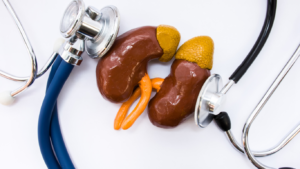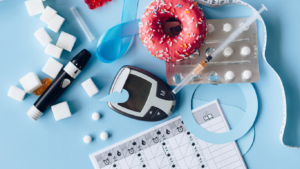Introduction
In the modern age, where fast food and sedentary lifestyles are becoming the norm, the rise of pre-diabetes across the globe is of significant concern.
People with pre-diabetes have a 50% chance of developing type-2 diabetes in the upcoming 5 – 10 years of their life. You can still prevent type-2 diabetes by making small changes in your lifestyle. Try the following 7 easy tips to reverse your pre-diabetes naturally.
What is Pre-Diabetes?
Prediabetes is a health condition where blood sugar levels are higher than normal5 but not high enough yet to be diagnosed as type 2 diabetes. This stage is sometimes referred to as an “intermediate” stage in the development of diabetes.
People with prediabetes are at an increased risk of developing type 2 diabetes, heart disease, and stroke.
Factors that increase your risk for prediabetes include:
- Being overweight or obese.
- Being aged 40 or older.
- Having a close family member with type 2 diabetes.
- Being physically inactive.
- Having a history of gestational diabetes or giving birth to a baby weighing more than 4 kg.
- Being of certain ethnic backgrounds, such as African, Caribbean, Middle Eastern, South Asian, or Hispanic.
- Having polycystic ovary syndrome (PCOS).
- Having conditions associated with insulin resistance like metabolic syndrome.
How is it Diagnosed?
Prediabetes can be diagnosed through various blood tests:
- Fasting blood sugar test: This measures your blood sugar after an overnight fast. A reading between 6.1 and 6.9 mmol/L (millimoles per litre) indicates prediabetes.
- Oral glucose tolerance test (OGTT): This test involves fasting overnight and then drinking a sugary solution. Your blood sugar is tested before and 2 hours after drinking the solution. A 2-hour reading between 7.8 and 11.0 mmol/L suggests prediabetes.
- HbA1c test: It measures your average blood sugar levels over the past 2-3 months. A result between 42 and 47 mmol/mol indicates prediabetes.
7 Tips to Reverse Pre-Diabetes Naturally
1. Start Eating Clean
It might sound cliche, but what you eat directly affects your blood sugar levels. Your diet should be rich in whole grains, lean proteins, and a variety of fruits and veggies. Avoid sugary drinks and opt for water or herbal teas.
Furthermore, including foods with a low glycemic index can help keep sugar levels stable. Here’s a quick peek:
- Whole grains: Like quinoa, barley, and oatmeal.
- Lean proteins: Think chicken, fish, and tofu.
- Low glycemic foods: Berries, non-starchy vegetables, and beans.
2. Regular Physical Activity
According to the American Diabetes Association, engaging in physical activities lowers blood sugar levels for as long as 24 hours after a workout.
“Movement is a medicine for creating change in a person’s physical, emotional, and mental states.” – Carol Welch
Regular exercise can help increase insulin sensitivity, meaning your cells can better utilise available sugar in your bloodstream. Aim for a mix of aerobic exercises and strength training. Walking, swimming, and yoga are great starting points.
3. Maintain a Healthy Weight
According to research, You can significantly lower your chances of developing Type 2 diabetes by up to 58% when you shed 5% to 7% of your body weight and engage in at least 150 minutes of exercise per week.
“To keep the body in good health is a duty. Otherwise, we shall not be able to keep our mind strong and clear.” – Buddha
If you’re starting a new exercise routine, it’s a good idea to take it easy at first. Begin with around 15 to 20 minutes of gentle physical activity. And after a few days, you can gradually increase both the intensity and duration of your workouts.
4. Quit Smoking
Quitting smoking is a challenging but rewarding journey. Here are some steps to help you quit smoking:
Set a Quit Date: Choose a specific date to quit smoking. This will give you time to prepare mentally and make any necessary arrangements.
Get Support: Tell your friends and family about your decision to quit smoking and ask for their support. You can also join a support group or seek professional help.
Identify Triggers: Pay attention to situations, people, or emotions that trigger your smoking habit. This can help you develop strategies to avoid or cope with these triggers.
Find Alternatives: Replace smoking with healthier habits. Chew sugar-free gum, snack on fruits or vegetables, or engage in exercise or meditation to manage cravings.
5. Change Your Eating Habits
Changing your eating habits can be a challenging task but worthwhile endeavour. Here are some steps to help you get started:
Set Clear Goals
Define why you want to change your eating habits. Whether it’s to improve your health, lose weight, or have more energy, having a clear goal will provide motivation.
Educate Yourself
Learn about balanced nutrition. Understand the different food groups, portion sizes, and the importance of nutrients like protein, carbohydrates, fats, vitamins, and minerals.
Portion Control
Pay attention to portion sizes. Use smaller plates and utensils to help control your portions and prevent overeating.
6. Manage Stress
Did you know that chronic stress can elevate your blood sugar levels? When you’re stressed, hormones like cortisol rise, which can, in turn, increase glucose levels.
Embrace meditation, deep breathing, and even hobbies that calm your mind.
7. Stay Hydrated
it sounds simple, but drinking ample water aids in maintaining healthy blood sugar levels. Besides keeping you hydrated, water helps the kidneys expel excess sugar through urine. Aim for at least 2 litres a day, more if you’re physically active.
“Take care of your body. It’s the only place you have to live.” – Jim Rohn
Reversing pre-diabetes is not an overnight miracle. It’s a journey that requires dedication, consistency, and patience. The silver lining is that every step you take towards a healthier lifestyle not only combats pre-diabetes but enhances your overall health and well-being.



